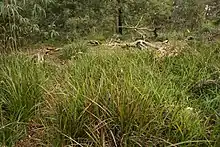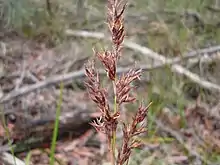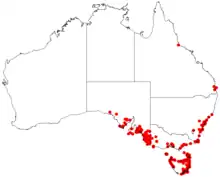Lepidosperma concavum
Lepidosperma concavum, commonly known as the sandhill sword-sedge, is a plant found in coastal regions of south-eastern and eastern Australia. It grows on sandy soils in woodland, forest and heathland.[1]

| Sandhill sword-sedge | |
|---|---|
 | |
| Scientific classification | |
| Kingdom: | Plantae |
| Clade: | Tracheophytes |
| Clade: | Angiosperms |
| Clade: | Monocots |
| Clade: | Commelinids |
| Order: | Poales |
| Family: | Cyperaceae |
| Genus: | Lepidosperma |
| Species: | L. concavum |
| Binomial name | |
| Lepidosperma concavum | |
 | |
| Occurrence data from AVH | |
| Synonyms | |
| |
Description
The sandhill sword-sedge is a tufted perennial with a short vertical rhizome and rigid, erect, sharp-edged culms. It grows to 20–60 cm in height and 3–7 mm in width. The inflorescence is erect, dense, ovate to oblong, 3–15 cm long and 2–4 cm in diameter, with a shorter involucral bract. The numerous spikelets are 5–8 mm long, with 6 to 8 bracts, covered in short fine hairs, red-brown to grey-brown. There are 6 scales at the base of stamen, whitish in colour. The smooth, pale to dark brown, ovoid nut is 2.7–4.0 mm long and 1.3–1.8 mm in diameter. It flowers in spring and summer.[1][2]
References
- "Lepidosperma concavum, PlantNET - NSW Flora Online". Retrieved 13 April 2012.
- Boyce, Lauran (2018). The terrestrial plants of the Rickett's Point Urban Sanctuary : Beaumaris Vic 3193. [Beaumaris, Victoria]: MESAC. p. 41. ISBN 978-1760019716.